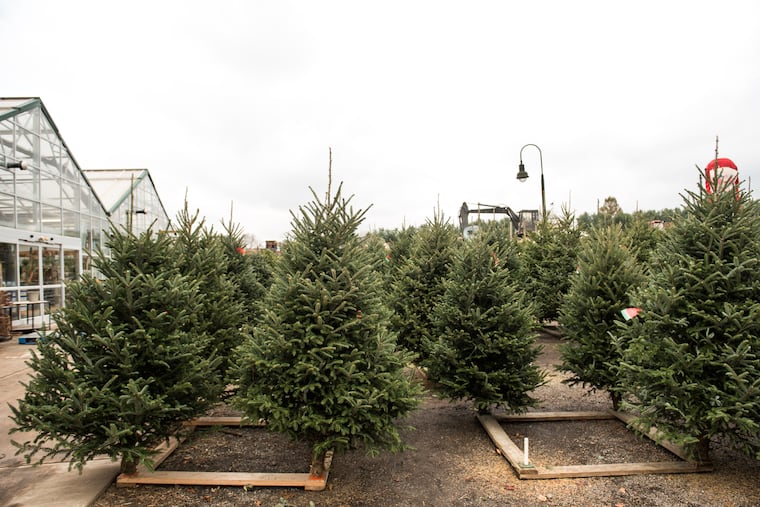How to pick (and maintain) the perfect Christmas tree this holiday season
Use these expert tips to help pick out the perfect Christmas tree and keep it thriving through the New Year.

Cue the holiday tunes: It’s time to pull out those decorations and pick out a Christmas tree.
Want to make sure you’re choosing the best possible option? Linvilla Orchards’ farm manager Norm Schultz shares advice on how to select the ideal evergreen and how to keep it fresh through the New Year.
Choose the right variety
For the Philadelphia region, Schultz recommends three species: the Douglas fir, the Canaan fir, and the Fraser fir. When treated properly, all will hold their needles from now until the end of the year.
“The Douglas fir grows best in this climate, so if you go out to cut your own tree, that’s most likely what you’ll find,” says Schultz. “The species yields a nice, full tree that holds its needles longer than many other local species once it’s cut.”
The fullness of a Douglas fir makes it prime for decorations like colorful strings of cranberries and other ornaments hung upon the tree.
Canaan firs, on the other hand, offer stiffer branches with more space between each limb, which is ideal for larger and heavier ornaments.
“The Canaan fir is the next most widely grown tree and will hold its needles for about the same amount of time as the Douglas,” says Schultz. “It’s also more fragrant, so if you want more of that Christmas tree smell, go for the Canaan.”
But Fraser firs hold their needles best.
“The best grow up in the mountains of North Carolina, and many area farm stands will ship them in,” says Schultz.
Do a needle test
Once you settle on a tree, you’'ll want to do a needle test.
“Grab six inches from the outer end of a branch and pull on it lightly,” says Schultz. “If the needles fall off by sliding your hands over the branch, that tree likely has a problem.”
At least 99 percent of the needles should remain in tact, says Schultz.
Assess the color
An obvious indication of a tree’s health is its color. While it’s important to avoid trees with yellowing needles, brown needles toward the center of a tree aren’t cause for concern.
“An evergreen sheds its two-year-old needles, so there’s always a cycle of discolored needles towards the center of the trunk,” explains Schultz. “Most farms have a tree-shaker that will get rid of those old needles before you take it home.”
Wait until December to tree shop
For vibrant color that’ll last until the final days of the year, wait until December to get your tree.
If you cut the tree in November, keep it stored away for a week or two.
"Place it in a bucket of water in a cold garage or in a shaded area outside,” he says.
Pull out the measuring tape before you leave your house
Forgetting to measure ceiling height is one of the most common mistakes tree-shoppers make.
“Trees don’t look so tall out in an open field, so people often end up buying one that’s way too big,” says Schultz. “It can make for a good story but also adds a lot of unnecessary stress.”
For precut trees, ask for a fresh cut
If opting for a precut tree, make sure to ask for a “fresh cut”.
“You want to saw off an inch from the bottom of the trunk to open up the area where the water’s being taken up,” says Schultz. “As it sits, sap can plug up the outer edge where the water gets absorbed.”
Choose the right stand
One-size-fits-all doesn’t apply to tree stands.
“A smaller stand won’t support the weight of a large tree, so it’s important to use a stand with recommendations that match the height of your tree,” says Schultz.
Stands will often add two or three inches to the overall height of the tree, another important factor to keep in mind as you assess the size of your space.
Avoid trimming the outside of the trunk to fit a tree into a tight stand
Avoid sawing off the outer edge of a trunk to fit it in the stand.
“It’s not in the center, but just underneath the bark where the water travels up to keep the needles fresh,” says Schultz. “Saw off the edges, and you’ll kill the tree’s life supply.
House your tree in a cool spot
Place your tree away from your heaters.
“Your tree will keep its needles for the longest if it’s in the coldest spot of your house,” he says.
Never let a tree go thirsty
“There’s no such thing as overwatering a tree,” says Schultz. “Christmas trees are like cut flowers — you’d never leave them in an empty vase.”
If a tree trunk gets dry, even for just a few hours, it loses its ability to soak up more water.
“The sap seals over the bottom of the tree, so even if you add more water to the stand, it won’t soak it up,” says Schultz.
Depending on the size, a tree can absorb a few quarts of water or more per day. Seek out a stand that holds at least a gallon of water if you don’t want to water daily.
Expert sources
Norm Schultz, farm manager at Linvilla Orchards, 137 W. Knowlton Rd., Media, 610-876-7116, linvilla.com